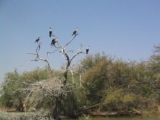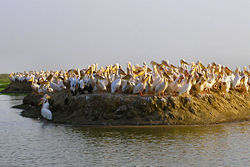
Djoudj National Bird Sanctuary
Encyclopedia
The Djoudj National Bird Sanctuary lies on the southeast bank of the River Senegal in Senegal
, in northern Biffeche
, north east of St-Louis
. It provides a range of wetland
habitats which prove very popular with migrating
bird
s, many of which have just crossed the Sahara
. Of almost 400 species of birds, the most visible are pelican
s and flamingo
s. Less conspicuous are the Aquatic Warbler
s migrating here from Europe
; for these, the park is the single most important wintering site yet discovered http://www.birdlife.org/news/news/2007/02/aquatic_warbler_senegal.html. A wide range of wildlife
also inhabits the park, which is designated a World Heritage Site
. The site was added to the list of World Heritage in Danger in 2000 due to the introduction of the invasive giant salvinia
plant, which threatens to choke out the park's native vegetation. However it was removed from the list in 2006

Senegal
Senegal , officially the Republic of Senegal , is a country in western Africa. It owes its name to the Sénégal River that borders it to the east and north...
, in northern Biffeche
Biffeche
Biffeche or Bifeche is an area of Senegal centred on the town of Savoigne, some 20 miles north-east of the major coastal city of Saint-Louis....
, north east of St-Louis
Saint-Louis, Senegal
Saint-Louis, or Ndar as it is called in Wolof, is the capital of Senegal's Saint-Louis Region. Located in the northwest of Senegal, near the mouth of the Senegal River, and 320 km north of Senegal's capital city Dakar, it has a population officially estimated at 176,000 in 2005. Saint-Louis...
. It provides a range of wetland
Wetland
A wetland is an area of land whose soil is saturated with water either permanently or seasonally. Wetlands are categorised by their characteristic vegetation, which is adapted to these unique soil conditions....
habitats which prove very popular with migrating
Bird migration
Bird migration is the regular seasonal journey undertaken by many species of birds. Bird movements include those made in response to changes in food availability, habitat or weather. Sometimes, journeys are not termed "true migration" because they are irregular or in only one direction...
bird
Bird
Birds are feathered, winged, bipedal, endothermic , egg-laying, vertebrate animals. Around 10,000 living species and 188 families makes them the most speciose class of tetrapod vertebrates. They inhabit ecosystems across the globe, from the Arctic to the Antarctic. Extant birds range in size from...
s, many of which have just crossed the Sahara
Sahara
The Sahara is the world's second largest desert, after Antarctica. At over , it covers most of Northern Africa, making it almost as large as Europe or the United States. The Sahara stretches from the Red Sea, including parts of the Mediterranean coasts, to the outskirts of the Atlantic Ocean...
. Of almost 400 species of birds, the most visible are pelican
Pelican
A pelican, derived from the Greek word πελεκυς pelekys is a large water bird with a large throat pouch, belonging to the bird family Pelecanidae....
s and flamingo
Flamingo
Flamingos or flamingoes are gregarious wading birds in the genus Phoenicopterus , the only genus in the family Phoenicopteridae...
s. Less conspicuous are the Aquatic Warbler
Aquatic Warbler
The Aquatic Warbler, Acrocephalus paludicola, is an Old World warbler in the genus Acrocephalus. It breeds in temperate eastern Europe and western Asia, with an estimated population of 15,000 pairs. It is migratory, wintering in west Africa...
s migrating here from Europe
Europe
Europe is, by convention, one of the world's seven continents. Comprising the westernmost peninsula of Eurasia, Europe is generally 'divided' from Asia to its east by the watershed divides of the Ural and Caucasus Mountains, the Ural River, the Caspian and Black Seas, and the waterways connecting...
; for these, the park is the single most important wintering site yet discovered http://www.birdlife.org/news/news/2007/02/aquatic_warbler_senegal.html. A wide range of wildlife
Wildlife
Wildlife includes all non-domesticated plants, animals and other organisms. Domesticating wild plant and animal species for human benefit has occurred many times all over the planet, and has a major impact on the environment, both positive and negative....
also inhabits the park, which is designated a World Heritage Site
World Heritage Site
A UNESCO World Heritage Site is a place that is listed by the UNESCO as of special cultural or physical significance...
. The site was added to the list of World Heritage in Danger in 2000 due to the introduction of the invasive giant salvinia
Giant salvinia
Salvinia molesta, commonly known as giant salvinia or kariba weed after it infested a large portion of the reservoir of the same name, is an aquatic fern, native to south-eastern Brazil. It is a free floating plant that does not attach to the soil, but instead remains buoyant on the surface of a...
plant, which threatens to choke out the park's native vegetation. However it was removed from the list in 2006


